Gender Equality and the Empowerment of Women and Girls in the Middle East and the Maghreb, 2015-16 to 2019-20
Evaluation Report
Prepared by the International Assistance Evaluation Division (PRA)
Global Affairs Canada
March 2021
Abbreviations
- CFSI
- Canadian Foreign Service Institute
- DAC
- Development Assistance Committee
- EGM
- Europe, Artic, Middle East and Maghreb Branch
- EMT
- Empowerment measurement tool
- FPDS
- Foreign Policy and Diplomacy Service
- GAC
- Global Affairs Canada
- GBA+
- Gender Based Analysis Plus
- GBV
- Gender based violence
- GE
- Gender equality
- IAE
- International Assistance Envelope
- IFM
- International Security and Political Affairs Branch
- IRD
- Peace and Stabilizations Operations
- MHD
- International Humanitarian Assistance Bureau
- KFM
- Partnerships for Development Branch
- KGAI
- Partnerships for Development Innovation – Impact Assessment
- MGS
- Gender Equality Division
- ODA
- Official development assistance
- OECD
- Organisation for Economic Co-operation and Development
- PRISMA
- Preferred Reporting Items for Systematic Reviews and Meta-Analyses
- PSEA
- Prevention of sexual exploitation and abuse
- SGBV
- Sexual and gender-based violence
- TVET
- Technical and vocational education and training
- UNRWA
- United Nations Relief and Works Agency
- UNSC
- United Nations Security Council
- WASH
- Water, sanitation and hygiene
Executive Summary
This thematic evaluation of gender equality and women’s empowerment examined international assistance programming in the Middle East and the Maghreb from 2015-16 to 2019-20 that targeted or fully integrated gender equality. The geographic scope included Egypt, Iraq, Jordan, Lebanon, Morocco, Syria, West Bank and Gaza, and Yemen. The evaluation aimed to inform decision-making, better understand women’s empowerment and improve Canadian programming. This report presents the evaluation findings, conclusions, recommendations and considerations for horizontal learning.
Despite their differences (geographic location, conflict vs. non-conflict areas, age, marital status, migration status, socio-economic status, race, disability, etc.), the women we spoke to had a common understanding of empowerment and gender equality. They valued their ability to choose and make decisions freely for themselves and for their families. Women identified human rights and the appreciation of their important role in society as key concepts for gender equality. These definitions align with Canada’s vision and policies on gender equality and women’s empowerment, which are based on 3 mutually reinforcing concepts of decision-making, human rights and access to and control over resources.
Despite the limited outcome data, we found that women who participated in various types of projects that targeted or fully integrated gender equality felt empowered. For these women, empowerment took place when they actively participated in project activities. In order to sustain these empowerment gains, the environment should support this meaningful participation and encourage the further active participation in project activities of other influential agents of change in women’s lives, including family and male figures.
Corporate gender equality policies, processes, tools and guidance have positively positioned Global Affairs Canada to achieve outcomes related to gender equality and women’s empowerment. However, the evaluation found it difficult to assess these achievements due to limited documented outcomes. Furthermore, the introduction of the Feminist International Assistance Policy within the department was not matched with a timely implementation strategy and related supporting tools and training. This created confusion and knowledge challenges among staff and partners.
The COVID-19 pandemic, which arose after this evaluation was designed, exposed vulnerabilities in the region’s social, political and economic systems and created disruptions with respect to women’s feelings of empowerment. Women’s empowerment disruptions have already emerged in political representation and decision-making, economic inclusion, access to education, access to information and technology, access to health, protection and social services, and mobility. Women and girls are experiencing fewer economic opportunities, loss of jobs, reduced wages, unfair working conditions, violence and poverty. Nevertheless, initial indications are that the pandemic created opportunities to continue connection through digital channels for social networking and project programming.
Summary of recommendations
- Increase the focus on enabling the environment to support women’s empowerment.
- Coordinate efforts for increased accessibility of gender equality resources across MGS (Gender Equality Division), IRD (Peace and Stabilizations Operations), and KGAI (Partnerships for Development Innovation – Impact Assessment).
- Collect empowerment data using women-focused, participatory methods.
Evaluation scope and methodology
Evaluation scope and objectives

Case studies: Morocco, Egypt, West Bank and Gaza, Lebanon, Jordan, Syria, Iraq, and Yemen

The voices of 258 women were at the centre of this evaluation
Evaluation scope
The evaluation focused on gender equality (GE) and women’s empowerment programming in the Middle East and the Maghreb region. The evaluation scope included international assistance programming from 2015-16 to 2019-20. This included humanitarian, development, peace and stabilization, and partnership projects that either fully integrated gender equality (GE2), or were specifically designed to advance gender equality (GE3) according to the Global Affairs Canada’s gender equality coding framework. Two projects, coded as having limited gender equality design components (GE1), were also included by request as they were seen to have achieved significant results for advancing women’s empowerment. Related diplomacy interventions were mapped to determine if activities complemented programming and supported the achievement of results.
Evaluation objectives
- Measure gender equality and women’s empowerment results achieved in the region
- Determine if departmental processes have positioned Global Affairs Canada to achieve gender equality results
- Identify factors for success in supporting women’s empowerment and achieving gender equality results
Evaluation approach
Evaluation methods were designed based on:
- Feminist evaluation principles: The evaluation incorporated some feminist elements: participation, inclusivity, intersectionality, and empowerment in the data collection process and during capacity building activities.
- Appreciative inquiry techniques: Interviews and focus group methods sought to focus on strengths, success and possibilities so that participants walked away feeling hopeful about the advancement of gender equality.
- Innovative methods and tools: The empowerment measurement tool (EMT) was created utilizing the Outcome Harvesting approach and Most Significant Change models to collect qualitative impact data.
- Conflict-sensitive evaluation principles: The evaluation applied protocols for collecting and protecting participants and their data based on Canada’s privacy law and internationally recognized protection standards. Project design was also assessed according to the Organization for Economic Co-operation and Development’s (OECD) Principles for Good International Engagement in Fragile States and Situations.
Adaptation and innovation during COVID-19
The evaluation plan and tools were revised in response to the emerging COVID-19 pandemic. Local female researchers were hired in case-study countries and territories, and they used virtual platforms to conduct online focus groups. The evaluation also developed a new line of evidence to understand the emerging impacts of the COVID-19 crisis on the sustainability of gender equality results achieved.
Evaluation questions
| Evaluation issue | Questions |
|---|---|
| Results | Q1. What were the reported gender equality and women’s empowerment impacts as a result of international assistance programming, and what diplomatic interventions supported these impacts? |
| Departmental tools and processes | Q2. To what extent did departmental gender equality guidance, processes and support, and program-level practices position Global Affairs Canada to achieve gender-transformative* results in the Middle East and the Maghreb region? |
*Canada’s National Action Plan for the Implementation of the United Nations Security Council Resolutions on Women, Peace and Security 2017-2022 notes that gender-transformative interventions “go beyond gender responsiveness. They aim to transform unequal gender relations to promote shared power, control of resources, decision making, and support for the empowerment of women and girls.”
Methodology
The evaluation used a mixed-methods and iterative approach, where data was collected across multiple lines of evidence and analyzed in individual technical reports. All methods were adapted to COVID-19 health and safety restrictions when applicable. This evaluation used 9 main methods.
Document review and financial analysis
Analysis of internal documents and financial information:
- 2 evaluation reviews
- 8 country reports and 1 theory of change review
- policy and planning documents
- financial data for 166 projects
COVID 19 expert review
N = 17 expert interviews (1M/16F)
Interviews with experts on regional COVID19 impacts and a review of publications:
- online semi-structured interviews with experts (2 Canadian and 15 regional)
- 180 documents from academic organizations, UN, World Bank, NGOs, donors
Project reviews
Review of 509 documents from 98 projects:
- project proposals, approval memos and GE assessments
- project implementation plans
- management summary reports, annual reports
- evaluations
Implementing partner survey
N = 44 partner organizations
Survey of implementing partners:
- organizations based in Canada and internationally
- partners with projects within the evaluation scope
- questioning focused on GE processes, tools and processes
Empowerment analysis
N = 45 projects / 45 focus groups (42 F, 2M, 1 M/F), N = 258 participants (251 F), N = 132 partner interviews
Data collected by local researchers with participatory focus group discussions:
- simplified tool created with feminist research team that incorporated elements of Most Significant Change and Outcome Harvesting methodologies
- addendum tool for enabling environment projects
- consent and privacy considerations checklist for discussion participation
- interviews with 44 partners in 5 countries/territories
- online semi-structured interviews: 4 (Egypt), 17 (West Bank and Gaza), 13 (Jordan), 5 (Lebanon), 5 (Morocco)
GAC staff survey
N = 255 respondents (157 W, 78 M, 20 other/N/A)
Survey of GAC staff across International Assistance Envelope (IAE) programming and policy branches:
- respondents from missions and HQ
- questioning focused on internal gender equality processes, tools, and practices
Global Affairs Canada gender equality process analysis
N = 35 GAC staff (F/M)
Review of GE processes and practices conducted together with a consultant:
- interviews with GE staff
- review of 80 corporate documents; CFSI course evaluation data for “Integrating GE into Programming” and “Managing for GE Results”; web analytics data
Systematic review of men and boys programming
Analysis prepared by Nordic Consulting Group:
- 58 documents using the Preferred Reporting Items for Systematic Reviews and Meta-Analyses (PRISMA) steps of identification, screening, eligibility and inclusion
Diplomatic analysis
Analysis of FPDS Strategia data for GE coded activities:
- 104 FPDS GE initiatives
- quantitative and qualitative data of primary (58) and secondary (46) initiatives categorized as action, willingness and awareness
Evaluation limitations and measures
| Limitations | Mitigation measures |
|---|---|
| Lack of project results data Available department data related to gender equality and women’s empowerment programming in the Middle East and the Maghreb was primarily at the output level. Results reporting was focused on numbers of engaged participants at the output level. There was little data at either the immediate or intermediate outcome levels; less than half (47%) of the sampled projects included any outcome-level documentation. When outcome data was available, it was usually vague, incomplete and not disaggregated. Relevant project documentation was inaccessible in some cases. | Lack of project results data In response to limited project results data, the evaluation team engaged Canadian feminist researchers to create the Empowerment Measurement Tool (EMT) to collect empowerment data from female project participants. The tool was field-tested, revised and facilitated by 5 local researchers in sampled countries/territories with expertise in gender equality and participatory methods. Technical reports with outcome results data were distributed to relevant evaluation stakeholders following data collection. |
| Access to relevant expertise Data collection was undertaken throughout the COVID-19 pandemic, during which there was limited but emerging data related to its impacts on women and girls. Further limits were encountered when seeking Canadian expertise and because of the unavailability or inaccessibility of experts on gender equality and COVID-19 in the region. In some cases, languages barriers added challenges to engaging a number of renowned regional gender equality experts. | Access to relevant expertise The evaluation team consulted international and regional evaluation networks and databases of experts while also engaging research contacts. Additionally the local researchers identified experts and relevant documentation. Given the rapidly emerging crisis, COVID-19 data was based on early assumptions and best estimates from trusted sources including UN agencies and non-governmental organizations. Data was complemented with interviews, where language barriers were overcome through translation of written Arabic responses. All discussions with female project participants were in Arabic. |
| COVID-19 Due to the rapid spread and unpredictable nature of the COVID-19 pandemic, all in-person data collection was cancelled to comply with global health and safety guidance and Government of Canada requirements. Additionally, increased isolation of women in remote and rural areas produced challenges for engaging women and increased the security and privacy risks of project participants. | COVID-19 The EMT was adapted with the local researchers to best align with ground-level COVID-19 realities. The tool’s final version was revised for online scenarios and based on advice from implementing partners on participant lists and how best to engage in discussions. The evaluation team developed data protection protocols to uphold the Do No Harm principle for participants and adherence to protection standards. |
Background
Gender equality direction
Definitions
Global Affairs Canada’s definition of gender equality is inclusive of fairness, social value, and agency, while having the equal opportunity to contribute meaningfully in inclusive and democratic societies. It is based on the equal opportunity to realize full human rights and potential. Considering intersectionality is central to Canada’s Gender Based Analysis approach (GBA+). This is a process for examining a policy, program or initiative for its varying impacts on diverse groups of women and men, girls and boys, and it is required for all projects or initiatives of the Government of Canada.
Women’s empowerment is the ability of women to take control of their lives, which includes setting one’s own agendas and goals, gaining skills, building self-confidence, problem solving, and developing self-reliance. It is viewed as a process and an outcome in and of itself. Women’s empowerment is central to achieving gender equality.
Since the 1970s, Canada has continued to build on its definitions and policies for gender equality and women’s empowerment in international assistance.
Gender Equality Policy: The department’s gender equality policy guidelines were first established in 1976. The policy was updated in 1999 to mainstream gender equality into all international assistance programming. It includes a focus on the importance of gender analysis and key priorities: advancing women’s position as decision-makers; the realization of women’s human rights; and women’s access and control over resources.
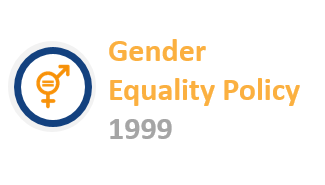
The Feminist Foreign Policy (since 2016) applies a feminist approach across all of its international policies and programming, including diplomacy, trade, security, development, and consular services. This builds on a series of sectoral feminist policies and initiatives developed in recent years, of which two are:
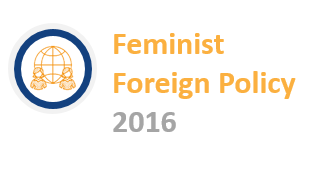
Feminist International Assistance Policy: This 2017 policy applies to all investments within the International Assistance Envelope (IAE) and defines programming within 6 action areas: Gender Equality and the Empowerment of Women and Girls; Human Dignity; Growth that Works for Everyone; Environment and Climate Action; Inclusive Governance; and Peace and Security. It seeks to increase GE integration and targeted transformation to a combined 95% of the IAE by 2021-2022.
Canada’s National Action Plan on Women Peace and Security: Canada’s 2nd Plan was launched in 2017. Implemented by Global Affairs Canada and 8 other government departments and agencies, it applies to programming, policy and diplomatic efforts internationally and domestically. Its main priorities are advancing peace and security and the rights of women and girls in conflict, post-conflict and humanitarian settings.
GE program investments in the Middle East and the Maghreb
Middle East Strategy
The Middle East Strategy is a whole-of-government strategy, in effect since 2016, that aims to address the challenges resulting from conflict affecting Iraq, Syria, Jordan and Lebanon. Integrating gender equality is a priority for the strategy. Fully integrated gender equality programming (GE2) accounts for 32% and programming targeted towards transformation (GE3) accounts for 3% of disbursements, for a combined GE2 and GE3 total of $580 million out of $1.67 billion in total strategy disbursements.

Almost half of investments in the Middle East and Maghreb were fully gender- integrated or targeted.
Fully integrated (GE2) and Targeted (GE3) gender equality programming accounted for $463 million, or 45% of total disbursements between 2015-16 and 2019-20*. Most GE investments were at the GE2 level, with 35% of all projects integrating gender equality, equalling $367 million over the 5-year period. Likewise, 9% of GE investments were focused on GE transformative work (GE3). For the sample, GE2 and GE3 funding rose nearly 257%, from $35 million to $125 million.
Programming within the Europe, Arctic, Middle East and Maghreb Branch (EGM) and the International Security and Political Affairs Branch (IFM) contributed to 93% of total GE2 and GE3 disbursements in the sample. However, disbursements within the Partnerships for Development Branch (KFM) held the highest percentage of GE3 disbursements, at 24%, followed by EGM, with 22%. Most investments in gender equality programming in the sample took place within the department’s Human Dignity ($209 million), Inclusive Governance ($63 million), and Growth that Works For Everyone ($56 million) action areas. Twenty-four OECD-Development Assistance Committee (OECD-DAC) sectors were implicated in GE programming in the sample.
Summary of GE2 and GE3 programming by country/territory**
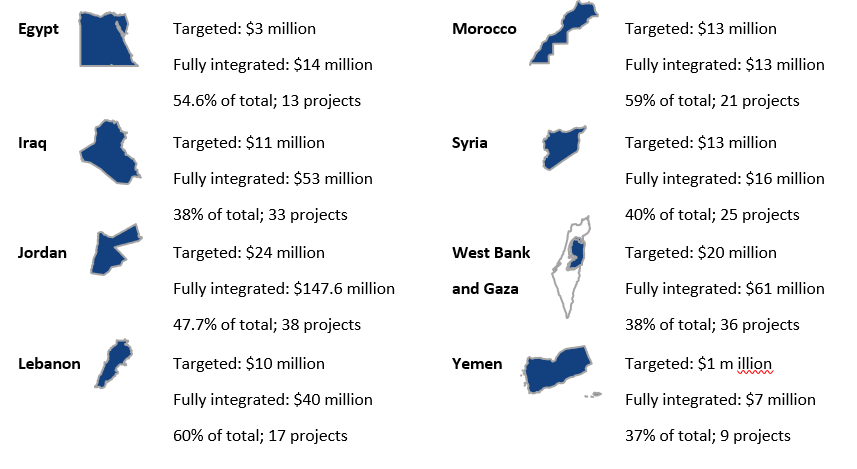
*Humanitarian projects managed by MHD were excluded from the sample, as they were beyond the scope of the evaluation.
** A further 11 multi-country projects are not reflected in this table as their country-level breakdown was not available.
Canada’s gender equality investments compared to OECD-DAC donors
Canada’s gender equality coding framework
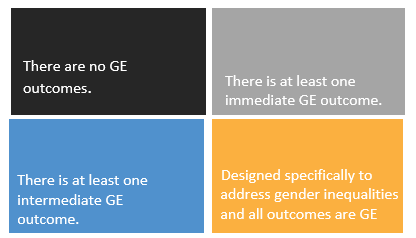
The application of a GE code is required to meet OECD-DAC commitments to report on financial contributions towards the Sustainable Development Goal on gender equality.
Canada’s investments in targeted gender equality programming are increasing.
The proportion of Canada’s investments targeting gender equality (GE3) in the Middle East and the Maghreb has expanded from 2% in 2015-16 to 8% in 2019-20, as seen in the graph on the left below. This is in alignment with the overall increase in investments in Canadian GE3 projects around the world.
In most years from 2015-16 to 2019-20, Canada spent a higher proportion of its assistance on GE3 projects in the region when compared with the proportion of overall OECD-Development Assistance Committee (OECD-DAC) donor spending. As a result, Canadian investments reflected a higher proportion of total donor GE3 spending in the region, as shown in the graph on the right.*
Percentage of total donor and Canadian investments coded GE3 in the Middle East and the Maghreb, by year
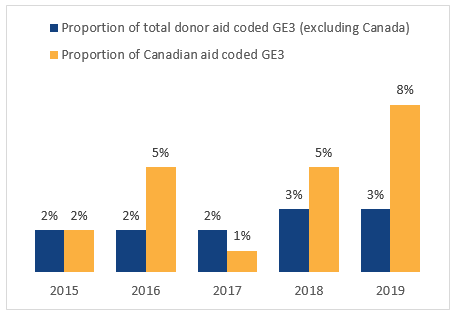
Text version
2015 :
Proportion of total donor aid coded GE3 (excluding Canada): 2%
Proportion of Canadian aid coded GE3: 2%
2016 :
Proportion of total donor aid coded GE3 (excluding Canada): 2%
Proportion of Canadian aid coded GE3: 5%
2017 :
Proportion of total donor aid coded GE3 (excluding Canada): 2%
Proportion of Canadian aid coded GE3: 1%
2018 :
Proportion of total donor aid coded GE3 (excluding Canada): 3%
Proportion of Canadian aid coded GE3: 5%
2019 :
Proportion of total donor aid coded GE3 (excluding Canada): 3%
Proportion of Canadian aid coded GE3: 8%
Canada’s share of total DAC-member GE3 disbursements, 2015-16 to 2019-20
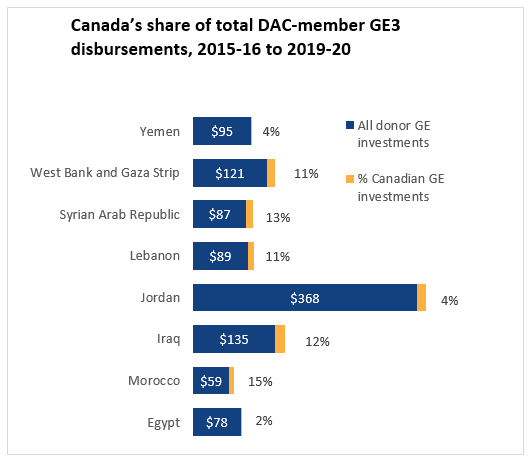
Text version
Yemen:
All donor GE investments: $95
% Canadian GE investments: 4%
West Bank and Gaza Strip:
All donor GE investments: $121
% Canadian GE investments: 11%
Syrian Arab Republic:
All donor GE investments: $87
% Canadian GE investments: 13%
Lebanon:
All donor GE investments: $89
% Canadian GE investments: 11%
Jordan:
All donor GE investments: $368
% Canadian GE investments: 4%
Iraq:
All donor GE investments: $135
% Canadian GE investments: 12%
Morocco:
All donor GE investments: $59
% Canadian GE investments: 15%
Egypt:
All donor GE investments: $78
% Canadian GE investments: 2%
*Canada’s system of GE codes varies somewhat from other donors. The figures on this page compare projects coded GE3 only, as this category is consistent with the practices of other donors. Data in graphs is from stats.OECD.org, and figures refer only to aid from OECD-DAC donors that has been screened for gender equality.
Feminist movements and limiting factors for gender equality
2020 World Economic Forum Global Gender Gap Index Ranking
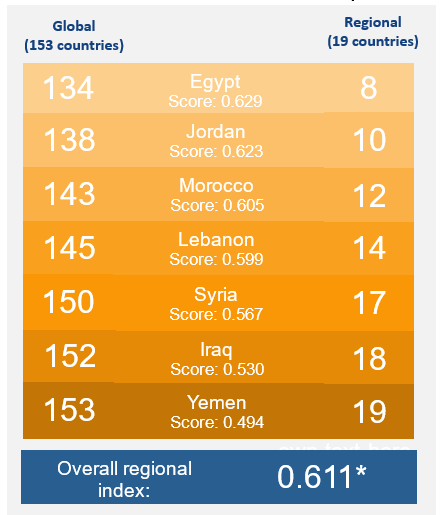
Note: the higher the score, the smaller the gender gap is. * West Bank and Gaza were not included in the Gender Gap Index. Regional ranking is provided for comparison.
There are known obstacles to supporting women's empowerment and the advancement of gender equality in the Middle East and the Maghreb.
Gender roles, practices, norms, and stereotypes in the sampled countries and territories are heavily reinforced by ingrained patriarchy which primarily disadvantage women and girls. In general, women have little access directly to resources and opportunities without direct family intervention. Understandings of gender dynamics favour males in position of power, in both economic and cultural terms. Familial and societal values are articulated through women’s actions and behaviour.
“Our society is male-dominant, so men can take advantage of the situation whether they made efforts or not. Men have more chances and less challenges compared to women.”
Traditional understandings of women’s role in society include concepts that they should not work and that they are solely responsible for family and child-care. Public life and politics are reserved for men. The region has some of the lowest rates of women’s economic participation in the world, where women are widely defined as wives and mothers first. Where women are involved in economic life, they face limitations generally due to societal and cultural barriers and norms.
Women have been significantly affected by the rise of extremist groups, conflict, economic instability and political insecurity in the region. Women make up the majority of displaced populations, experience high levels of domestic violence, and have limited opportunities to participate in public life, including peace processes. Armed conflicts in recent years have destroyed much of the progress toward increased gender equality.
Strategic inroads to support women's movements and partners exist, despite significant challenges.
The region experienced a general regression in human rights and serious challenges to civil society overall, in particular in Egypt, Syria and Yemen. However, some countries and territories have seen promising gains, including improved gender representation in legislation in Morocco, Iraq and Jordan.
Women’s groups across the region are engaged in many of the same issues, ranging from protection and advocacy to ending sexual and gender-based violence and impunity for these acts; increased women’s participation in public and political life; legal reform of discriminatory law; and increased access to economic opportunity. Women’s movements in the areas affected by long-term civil unrest and conflict are also focused on increasing women’s participation in peace processes and conflict resolution. Many grassroots women’s organizations are providing direct service support to women and girls in the sampled countries and territories.
Findings
Women’s empowerment definitions
Local voices on gender equality and women’s empowerment
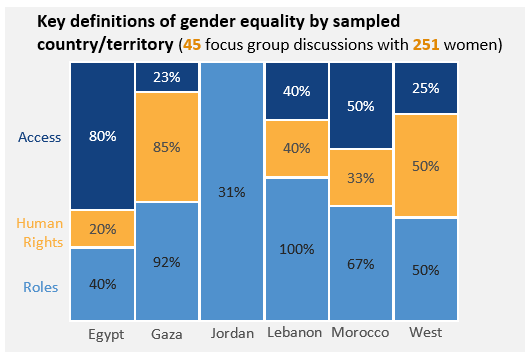
*Discussions with women in Jordan opted to focus on empowerment rather than GE. GE was discussed in 31% of Jordanian discussions with 100% of these conversations centred GE on women’s roles.
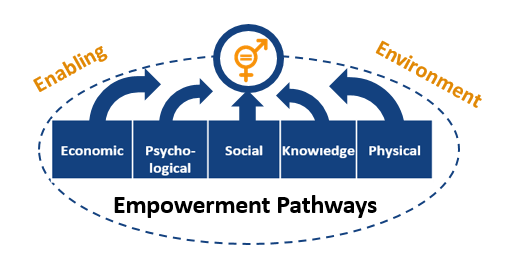
Canada’s vision for achieving gender equality and women’s empowerment aligned with women’s own definitions and aspirations. Women want their role in society respected, their human rights recognized and protected, and the power to make their own decisions.
Canada’s policies for supporting and promoting gender equality have 3 areas of focus: supporting women’s decision-making power; protecting human rights; and enhancing access to, and control over, resources.
Women’s definitions of gender equality
Roles: Over 60% of the discussions with women in the evaluation sample defined gender equality as society valuing the unique and important role of women. It was felt that when women are valued, they have a meaningful role in public and community life. These women want to be visible and respected. They want to see an equitable division of responsibilities between men and women, with women’s contributions recognized as equally important to those of men.
Human rights: 40% of discussions with women defined gender equality as protecting human rights. These women want access to health services, education, an independent income, and safety, as well as the ability to express their opinion, participate in the community, and engage in politics.
Access to resources: 28% of discussions with women defined gender equality as having control of resources. These groups of women want options and the ability to make choices about their education, employment, and financial services. They want freedom of movement, control of their own bodies, the ability to enjoy public spaces without harassment, and purchasing power.
Variances: Women’s definitions varied slightly by region and conflict situation. Women speaking in discussions from fragile and conflicted-affected areas focused more on the role of women in society and human rights (e.g. Gaza). In contrast, women in less fragile areas associated gender equality more with control of resources (e.g. 80% in Egypt sample).
Achieving gender equality through women’s empowerment and creating an enabling environment
The evaluation’s Empowerment Measurement Tool asked women to describe what ultimately leads to gender equality. Local feminist researchers presented Canadian assumptions that women were asked to validate, change, or expand. Women identified 5 pathways to achieving gender equality: economic empowerment, psychological empowerment, social empowerment, knowledge empowerment, and physical empowerment. They also described the need for an enabling environment that includes social acceptance, legal protection and gender-sensitive governance.
Women’s empowerment activities
Education and governance were the sectors with the largest investments in GE2 and GE3 programming
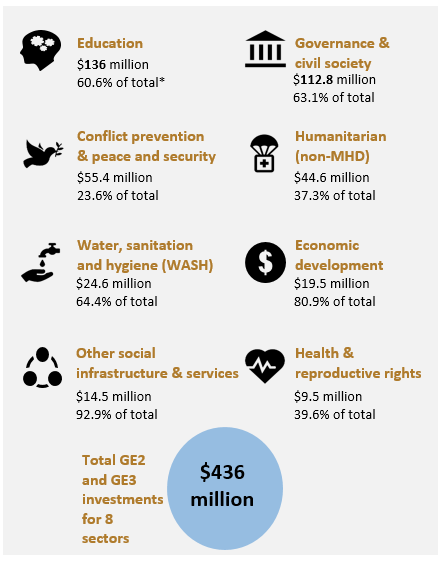
*Percent of total investments from 2015 to 2020, which were coded GE2 and GE3
Gender equality activities were responsive to the local context and focused primarily on capacity-building and awareness-raising. There were good examples of funded programming complemented by diplomacy.
Program activities
Funded programming was context-specific. Programming in Middle East Strategy countries responded to the impact of the Syrian civil war. Activities in Syria and Iraq focused on engagement with women on peace, advocacy and protection. In Jordan and Lebanon, the focus was on women and girls in education, economic development and governance through capacity-building, economic development and awareness-raising. Less fragile contexts, such as Morocco and Egypt, focused on mentoring and training for business and livelihood support; strengthening girls education; increasing institutions’ gender awareness and tailoring services; and raising awareness on rights and family planning. Activities in West Bank and Gaza were focused on providing humanitarian service delivery; raising awareness on nutrition, gender-based violence (GBV), and the differing needs for those living with disabilities; improving social services; and providing skills training for women and civil society organizations.
Key Stats from Project Review Sample (98 projects)
- 66% of projects focused on increasing women’s empowerment through skills, knowledge-building or income opportunities
- 60% of projects aimed to strengthen the enabling environment for women’s empowerment, especially at the institutional level
- 21% of projects meaningfully included men and boys; however, most projects did not aim to transform masculinities, but rather target men as allies and advocates
Quadrupling of investments over 4 years
Investments in the Gender Equality and the Empowerment of Women and Girls action area quadrupled in 4 years (2015-16 to 2019-20), from $5.2 million to $22.6 million, in the evaluation sample. Social infrastructure and economic development were the sectors with the highest percentages of GE2 and GE3 projects with between 80% and 93% of investments focused on GE work. This was followed by the education, governance and WASH sectors disbursing over 60% of investments in each.
Diplomacy
60% of gender equality diplomacy initiatives were awareness-based and often targeted media and youth. Initiatives included hosting cultural events, conferences and workshops on gender equality issues in the media and law, and challenging societal norms. Gender equality messaging was integrated into regular coordination meetings to increase policy dialogue on the subject.
Women’s empowerment outputs
A snapshot of key project outputs
These examples of available output data from documentation such as project reports highlight the breadth of results across sectors and approaches.
This snapshot of outputs represents a small fraction of the outputs achieved by partners for projects over the 5 year period and does not represent the entirety of outputs achieved.

Capacity-building and training
- 46,225 service providers trained in gender mainstreaming and integration
- 2,567 women trained in business and life skills development
- 1,158 gender-based violence survivors received psychosocial support and vocational training
- 128 trainers trained on case management and human rights
Awareness-raising and knowledge-sharing
- 19,000 women participated in economic empowerment programming
- 5,549 campaign activities for parents on importance of girls’ education
- 506 outreach sessions on women & girls’ rights and sexual and gender-based
- 11 outreach sessions for young male and female peacebuilders
Service provision
- 14,653 sexual and gender-based violence (SGBV) survivors received referral services
- 276 women referred to health centres
- 147 women benefited from facilitated access to credit
- 6 safe spaces created for women
Advocacy and dialogue
- 411 group discussions related to a national action plan
- 108 policy-makers consulted and sensitized to sexual and gender-based violence
- 101 women met with decision-makers for gender-sensitive reconciliation
- 32 community initiatives related to SGBV, peacebuilding and economic empowerment
Women’s empowerment outcomes
Empowerment pathways ranked by women in focus group discussions (45 focus groups with 251 women interviewed; numbers reflect the proportion of focus group discussions mentioning these pathways)
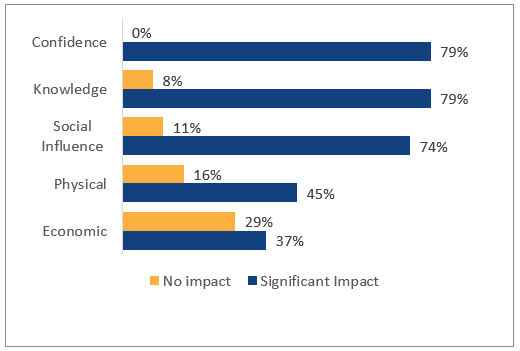
Text version
Confidence
No impact: 0%
Significant impact: 79%
Knowledge
No impact: 8%
Significant impact: 79%
Social Influence
No impact: 11%
Significant impact: 74%
Physical
No impact: 16%
Significant impact: 45%
Economic
No impact: 29%
Significant impact: 37%
During focus group discussions, women identified the ways in which their participation in GAC-funded projects had contributed to their feelings of empowerment. Overall, in the majority of discussions, women identified that their involvement in programming mostly led to increased self-confidence and increased knowledge which included a feeling of being better trained and skilled. Explanation of the ranking scale: No impact: very little or no impact to their individual everyday life. Significant impact: noticeable changes to structural barriers and power dynamics, larger changes to household, institutional, political barriers that led to greater gender equality.
Empowerment results were achieved through different types of interventions even when achieving gender equality was not the main project goal.
While projects are assigned a gender equality code by departmental gender specialists (i.e. 0-3), these codes are based on a project plan and do not necessarily reflect achieved project outcomes. A comparison of project outcomes demonstrated that women in the region experienced empowerment results regardless of their participation in projects that fully integrated gender equality elements into other thematic programming (GE2), or projects that were specifically designed to target gender equality results (GE3).
Overall, 82% of focus group discussions identified some or significant empowerment from participation in projects. Empowerment outcomes were most significantly demonstrated in economic- and governance-themed projects where women felt empowered by their increased access to income, and a feeling of being more confident overall in their abilities, including the ability to discuss gender equality issues more openly in their communities. Women identified these outcomes predominantly in West Bank and Gaza, Jordan and Morocco.
Note on GE1 partially integrated Projects: Although a United Nations Relief and Works Agency (UNRWA) Women and Girls in Technical and Vocational Education Training (TVET) programming in West Bank and Gaza was designed with limited gender equality elements (GE1), discussions with female students reported significant empowerment outcomes.
Extracurricular activities let female students take on influential roles and learn to challenge opinions
- participation helped change female students’ attitudes about their power to make change in their communities
- TVET institutions were safe spaces that allowed female students to create their own communities of support
- female students learned professional skills
Empowerment results were interconnected.
In the majority of discussions, empowerment did not result from one source. Women in focus groups identified empowerment in overlapping and connected ways. For example, an increase in self-confidence was commonly linked to both increased knowledge from training initiatives as well as increased income. Women in these discussions felt particularly valued and respected when they received income for their work and were able to provide for their families.
In 100% of all discussions across programming sectors, women voiced improved self-confidence as an outcome of their participation in projects. Women in the focus groups believed more in themselves and their ability to make positive change in their communities. Participating in projects also provided moments of relief and a safe space. Improved mental health was a strong theme in discussions within humanitarian projects, where women described feeling less hopeless and less ashamed as a result of their participation in programming.
Women in 43 focus groups in Egypt, Morocco, Lebanon, Jordan, and West Bank and Gaza indicated the types of empowerment they experienced as a result of their participation in programming. Women experienced the following outcomes ranked in order of impact.
Most Impactful
Psychological empowerment
Women had increased confidence and trust in themselves and in their ability to make decisions.
Significant impacts reported in Egypt, West Bank and Gaza, Jordan, Lebanon and Morocco.
- 54% of focus groups reported on their improved communications skills
- 93% of focus groups reported feelings of increased self-confidence
- 47% of focus groups discussed their newfound freedom to choose a career and make decisions for themselves
Knowledge empowerment
Women increased the knowledge and skills that they used to reach their goals.
Significant impacts reported in Egypt, West Bank and Gaza, Jordan, Lebanon and Morocco.
- women reported gaining learned practical technical skills, life skills, human rights and GE concepts which include legal rights
- 22% of focus groups reported that knowledge sharing and shared learning spaces were important to feelings of empowerment
Moderately impactful
Social influence
Women had greater ability to voice their concerns and make their own decisions.
Significant impacts reported in Egypt, West Bank and Gaza, Jordan, Lebanon and Morocco.
- 45% of focus groups identified they felt most empowered through their inclusion in networks, including interactions with business contacts and other women
- women in the focus groups indicated that they wanted to be decision-makers and to be engaged in legislation and politics
Physical empowerment
Women had greater control over their bodies, including mobility and access to services.
Significant impacts reported in West Bank and Gaza, Jordan and Morocco.
- 41% of focus groups expressed more freedom to move outside their homes and villages without an escort
- humanitarian programming provided safe spaces through emergency shelters and private bathrooms, and access to better quality gender-based violence services
Less impactful
Economic empowerment
Women had more sources of income and more power to decide how to spend money.
Significant impacts reported in West Bank Gaza and Jordan. Focus groups noted that:
- women had acquired new skills and were able to market themselves for employment
- women reported increased dignity because they contribute to family incomes
- women noted receiving more job prospects for recent female graduates and participants in education exchanges
- women identified more participation in male-dominated professions
- women highlighted small business creation in traditionally female-led industries

Enabling environments

Non-traditional roles and female role models
Women saw a positive change in support from their communities when they could publicly demonstrate success in their chosen profession.
Women’s focus groups identified the key sources supporting their empowerment results
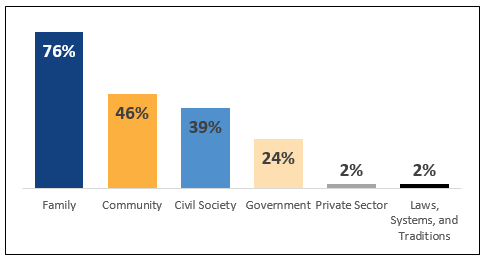
Text version
Family: 76%
Community: 46%
Civil Society: 39%
Government: 24%
Private Sector: 2%
Laws, Systems, and Traditions: 2%
Women’s empowerment required an enabling environment that included support from family, civil society, governments, local communities, laws and local traditions as well as the private sector. Programming that advocated in these sectors reported greater gains.
Men and boys
A systematic review of OECD-member-country evaluations found that despite poor documentation of impact, there is a growing recognition of the value of engaging men and boys as partners for change. Too few projects engage with men and boys adequately across the region. Women in the sample corroborated this sentiment: more than 75% of discussions indicated the importance of husbands’ and fathers’ support in women’s participation in empowerment programming and their ability to move freely outside the home.
In 81% of focus group discussions, women identified harmful cultural norms and gender stereotypes as significant barriers to an enabling environment for their empowerment. Women in focus groups discussed toxic masculine mentalities; a lack of opportunities; women and girls being held accountable for their family’s honour; and beliefs that women should remain in the home, and should submit to male leadership. For women that wanted to work outside the home, they indicated that long hours outside the home were not tolerated.
Funded partners provided anecdotal examples where programming was more successful when they actively engaged with husbands and fathers by demonstrating that it was in their best interest to support the initiative.
Family encouragement
Family support was critical in 76% of discussions in all sampled countries, and in 100% of discussions in Jordan, Lebanon and West Bank and Gaza. Families gave women the freedom and confidence to study, and the permission to look for employment. Families provided encouragement to continue towards one’s goals. Only 15% of projects focused their approaches on change at the family level.
Community-building and connections
30% of focus groups with women discussed feeling isolated and stuck at home. One in 4 felt home and community were unsafe spaces for women where sexual and gender-based harassment and violence were accepted by their community and/or government despite existing laws and services. Community was identified as a significant contributing factor of women’s empowerment. Programming that supported women through local engagement and networking increased women’s feelings of empowerment in 25% of projects. 45% of female business owners that participated in the focus groups felt more free and confident to network with partners and service providers, which had a positive impact on their businesses. Women could identify the key players and new clients, and networks provided greater exposure for their products.
Departmental GE tools and processes
Positioning for GE outcomes
GE code percentages achieved per year
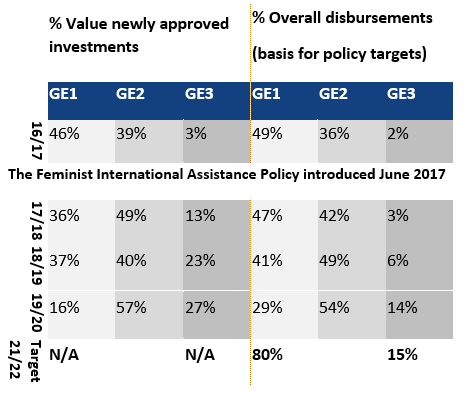
Text version
% Value newly approved instruments:
2016-17: GE1: 46%, GE2: 39%, GE3: 3%
2017-18: GE1:36%, GE2: 49%, GE3: 13%
2018-19: GE1: 37%, GE2: 40%, GE3: 23%
2019-20: GE1: 16%, GE2: 57%, GE3: 27%
Target 2021-22: GE1-GE2: N/A, GE3: N/A
% Overall Disbursements (basis for policy targets):
2016-17: GE1: 49%, GE2: 36%, GE3: 2%
2017-18: GE1:47%, GE2: 42%, GE3: 3%
2018-19: GE1: 41%, GE2: 49%, GE3: 6%
2019-20: GE1: 29%, GE2: 54%, GE3: 14%
Target 2021-22: GE1-GE2: 80%, GE3: 15%
The table above displays 2 sets of statistics that reflect progress on the targets set in the Feminist International Assistance Policy for global programming. The left-hand side of the table displays the percentage of the value of newly approved investments for projects coded GE1, GE2, and GE3. These numbers make clear the actual progress by year in new project approvals by GE code. The publicly reported Feminist International Assistance Policy targets are, however, based on overall disbursements, as shown on the right-hand side of the table. As these disbursements include projects approved years in the past, percentages can vary significantly compared to the value of newly approved investments.
Global Affairs Canada was well positioned to achieve gender equality outcomes as a result of establishing policy coverage, a GE assessment process, and departmental gender experts.
Programming designed to integrate and target gender equality outcomes increased with the introduction of the Feminist International Assistance Policy
The introduction of the Feminist International Assistance Policy strengthened Canada's existing focus on GE and women and girls' empowerment beyond the 1999 Policy on Gender Equality. The policy set ambitious targets to increase Canada’s investments in GE and positioned Canada to support the Sustainable Development Goals’ GE targets. By 2021-22, the policy requires that the department’s GE3 investments, in which advancing gender equality is the principal objective, move from 2% to 15% of investments. Overall progress was made on these targets as shown in the table to the left. Most significantly, in 2019-20, a $105 million commitment from the Equality Fund raised GE3 disbursements to 14%. While another large disbursement is expected from the Equality Fund in 2020-21, in 2021-22 additional GE3 programming would be needed to meet the 15% target. Achieving this target is expected to be a challenge due to the COVID-19 pandemic, as response programming will not likely be primarily centred on gender equality. Although achieving and maintaining a GE3 target may be a challenge, this evaluation found that gender equality could still be advanced through GE1 and GE2 projects that support women’s empowerment through various thematic programs.
GE assessment provided a standard process to identify programming designed to advance gender quality
A GE assessment has been a component of the international assistance project approval process since 2008 and requires project applicants to provide evidence of GE considerations. Project designs are assessed and coded based on evidence that a gender-based analysis was conducted; that GE expected results and indicators were established; and that the budget provided for GE activities. The assessment process and the GE codes assigned allow the department to identify and approve programming that is most likely to achieve gender equality results, and to report on international and national policy commitments. However, to know whether the final results achieved matched the GE code, a comparison of GE codes to results reported would be required, which has not been a practice at Global Affairs Canada.
Departmental GE specialists provided quality control and feedback on project designs. When surveyed, Global Affairs Canada staff managing international assistance projects positively perceived gender specialist support. 73% found that GE specialists’ advice improved programming design. 76% felt that working with departmental gender specialists strengthened their capacity in understanding of gender equality programming design.
Support for GE outcomes
Extent to which Global Affairs Canada staff agreed that they have a good understanding of current overarching policies related to GE

Text version
Strongly Agree: 36%
Agree: 54%
Neither agree nor disagree: 7%
Disagree: 2%
Don’t know; N/A: 1%
Extent to which GE codes consistently matched expectations of staff managing projects
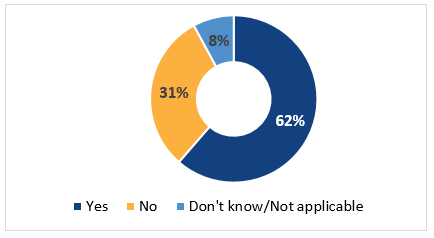
Text version
Yes: 62%
No: 31%
Don’t know; N/A: 8%
The Feminist International Assistance Policy’s introduction within the department was not matched with a timely expansion of related communication, training, tools and policies. These supports had not yet caught up to implementation needs.
Ambitious targets and a lack of clear communication challenged the GE assessment process
The importance of GE codes to project approvals increased with the introduction of the Feminist International Assistance Policy in 2017. To meet the policy targets, GE codes became essential to project approvals. As a result, there was increased scrutiny and questioning by project officers and senior management on the GE coding criteria. At times, the GE codes assigned were met with resistance.
The initial lack of clarity surrounding GE coding expectations and the criteria for the assignment of GE codes remained in the years following the policy’s introduction. There was a period of confusion during the first year surrounding the timeline for reaching the targets, and misunderstandings regarding approvals for projects not coded as GE3. Staff perceived that there was a requirement to refocus program portfolios immediately to reflect the new targets, although this was not the case. Further, the annual investment planning process set out anticipated GE codes for proposed initiatives in the absence of GE specialist involvement. Avenues to access guidance regarding the application of GE codes was also not well communicated.
In the subsequent 3 years, guidance and understanding improved. However, understanding of GE coding among staff and partners continued to be a gap. 31% of surveyed staff perceived that assigned GE codes did not consistently match their expectations and that project GE codes were inaccurate based on what they understood to constitute GE codes. 13% of surveyed partners also indicated that they did not receive information about their projects’ assigned GE code.
Increased demand for GE services coupled with unclear roles led to duplication of efforts and unmet needs
The policy put the responsibility for achieving GE outcomes on all staff, not just the Gender Equality Division (MGS) within the department. This required significant support to improve staff capacity. The GE division provided a central hub of expertise offering guidance, assessing project designs, and providing programs and missions with GE advocacy support. However, the division experienced a number of challenges. Most significantly, the division had limited capacity to support the large scope of increased requests related to international assistance programming. Furthermore, the division began to work more with political staff who were accessing support for the first time to implement the Feminist Foreign Policy. This increase in demand for services was further challenged by an unclear role for the division in supporting diplomacy initiatives. Similarly, there was not a clear division of responsibilities between GE policy advisors and GE programming specialists. The role of the Gender Equality Division was also not well known, leading to a duplication of efforts between corporate functions. For example, multiple divisions offered training and resources that implicated GE objectives and approaches.
Global Affairs Canada staff and partner survey highlights
Online GE tools

GAC GE expertise

GAC GE training
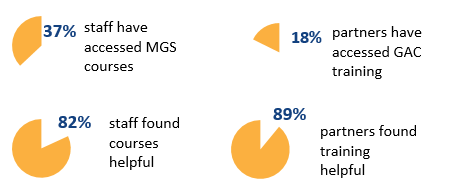
Supporting action area policies and implementation tools took time to create and were not easily accessible
When the Feminist International Assistance Policy was announced, supporting policies and tool kits on how to intrepret and implement the policy needed to be rapidly developed. Policy directives were launched in 2019, 2 years following the policy’s introduction. Over 4 years later, Performance Information Profiles (a key tool for measuring the intended results of the policy) had not yet been approved.
There was a lag in distributing the revised Gender Equality Toolkit. As the key resource for staff and partners for designing and implementing GE programming, the Toolkit was not made available internally to staff until 2018, and was not available online to the public and partners between 2015 and 2019. An updated version was completed in 2020 but had not yet been shared.
There was an increasing number of GE tools available for Global Affairs Canada staff over the time period, but their use was limited due to a lack of awareness on what was available and where to find tools. GE resources developed by the Gender Equality Division were housed on the department’s corporate digital resource hub; however, resources were outdated and key guidance materials were missing including links to GE advocacy resources developed by Global Affairs Canada available on the GCPedia portal.
84% of surveyed partners expressed that they had a good understanding of the policy and its implications for their work. 75% of these partners knew where to find guidance needed to comply with the department’s GE requirements. 85% of partners who consulted tools, guidance and policy directives found them helpful but had an interest in more guidance on GE coding.
GE advice and training was essential, but limited
The Gender Equality Division experienced challenges in maintaining staffing levels. This limited the availability of GE specialist advice. By 2020, the division was fully staffed. However, surveyed programming staff continued to perceive an insufficient number of GE specialists given the scope of GE work within the department. The department’s implementing partners were also not always able to receive GE support when required. 50% of surveyed partners indicated a desire for more GE technical support, especially on the topic of intersectionality.
The 2 core GE trainings offered by the GE Division had 254 unique participants from 2015 to 2020, or about 50 per year, and were not fully subscribed. The majority of staff found these trainings helpful, but surveyed staff indicated a desire for more GE training options. 49% indicated as a top priority: “Build capacity of GAC staff to address gender issues in their work.” Training offered to partners was ad hoc, with less than 20% of surveyed partners having participated.
Project level good practices for gender equality
Moving towards transformative results
Employing an enabling-environment lens can help ensure that results are effective and transformative
Model of the enabling environment

The GE approach in the Middle East and Maghreb aligned with several key elements for achieving transformative results, but more remains to be done. A key obstacle was the small pool of partners capable of implementing an ambitious gender transformative mandate.
Intersectional approaches and context specificity
Over half (57%) of projects made clear mentions of intersectionality considerations in line with a Gender Based Analysis Plus in project designs, and many incorporated participatory methods. Half of the projects in the sample were well aligned with the 2007 OECD Principles for Good International Engagement in Fragile States and Situations. The most aligned principles included using context as the starting point, alignment with local priorities and contexts, and ensuring longer-term engagement. Conversely, only 1/3 of the sampled projects clearly articulated a consideration of the Do No Harm principle.
Strengthened resilience focus through participation, and community-building for sustainable GE outcomes
Key factors for sustaining women’s empowerment observed by projects included the engagement of local actors, reinforcing local ownership and the use of women-led approaches. In all cases, women felt empowered by the sense of community created by projects. Women cited the need for more female role models, and recommended continued engagement and connection between female participants after project completion.
Inclusion of men and boys
Women expressed the desire for more significant involvement of men within GE and women’s empowerment projects. This interest was aligned to a 69% increase in the number of projects that articulated the inclusion of men and boys following the introduction of the Feminist International Assistance Policy. Evidence of their inclusion was found in 27% of the sampled projects, with the majority of these activities in GE3-coded projects. Some projects targeted women’s families with awareness-raising, and others planned to encourage positive masculinity behaviours. Outcomes of this work are unknown, and according to a systematic review of OECD donor country evaluations, greater emphasis on men’s roles and impact on GE programming is required.
Limited pool of partners who can facilitate transformative work
Few external partners were well-situated or resourced, or held the specific expertise necessary for GE transformative work. Very few international organizations have the institutional commitment, policies and capacity to design and implement GE3 projects. Almost 60% of surveyed staff chose “build capacity of partners to address GE” as a top priority. Over 1/3 of staff and almost 50% of KFM-surveyed partners believed that there are administrative barriers that prevent engaging a diversity of partners able to take on GE3 programming work.
Program level good practices for gender equality
The Middle East Strategy
The Middle East Strategy demonstrated good practices to help ensure that planning led to the achievement of results. GE integration required key activities at the planning, implementation and performance measurement stages of programming that could be more broadly replicated, particularly in fragile and conflict-affected states.
Planning
- officially approving a coherent strategy document linking all country initiatives with GE as a central component
- carrying out an internal staff needs assessment of GE capacities to understand gaps
- combining gender analysis and conflict analysis into one baseline tool to understand overlapping drivers of conflict and opportunities to address drivers and build peaceful foundations that consider gender differences
- identifying common GE objectives across programming
- presented GE in almost 70% of outputs, 78% of all immediate outcomes and 86% of all intermediate outcomes
- Presented in progress report on Canada’s National Action Plan on Women, Peace and Security targets in 72% of all outputs, 71% of all immediate outcomes and 86% of all intermediate outcomes
- included both individual and enabling environment outcomes at intermediate level
Implementation
- developing a GE implementation plan that outlines key considerations
- championing gender equality in the implicated countries
- supporting local women’s organizations
- sectoral checklists for operational resources, knowledge, accountability and communications related to specific mandates and program modalities
- ntegrating new programming that aligns with the strategy
- accessed the Women's Voice and Leadership Program as a vehicle to align local GE and empowerment expertise with needs
- improving capacity and knowledge of gender-sensitive, results-based management of staff and partners
- creating context-specific GE messages
- • communicated Canada’s support for GE in the Middle East Strategy countries
Performance Measurement
- collecting GE performance data against a baseline and targets that demonstrate progress in Canada’s National Action Plan on Women, Peace and Security
Examples of Middle East Strategy GE outcomes
- increased capacity of local governance stakeholders to develop and deliver gender-sensitive policies, programs and services in a manner that includes women’s meaningful participation in decision making
- increased gender-sensitive immediate access to assistance to meet basic human needs
Sustainability
COVID-19 emerging issues and innovative project adaptation

Digital innovations for women’s empowerment
Prior to the pandemic, partners in the Gaza Strip were already innovating in the digital space. Where there was a lack of a labour market to harness the high levels of educated women, projects like Gaza Sky Geeks used what was available to link men and women to viable income opportunities in more equitable ways in the global market and facilitate greater access to the Internet.
Women learned to market their skills online and developed new e-skills through digital literacy and coding activities. Coed collaboration in training scenarios allowed male colleagues to see firsthand what women can do, contributing to a change in male attitudes.
Emerging evidence indicated the COVID-19 pandemic was stalling empowerment and gender equality results. Although quarantine measures were essential for protecting lives, women had less access to sexual and reproductive health services and experienced loss of financial security, increasing familial tensions, isolation and more violence.
The pandemic led to disruptions across all areas of women’s lives, particularly on mobility. Confinement isolated women to their communities and homes. It increased the burden of and time spent on unpaid care work and reinforced unequal gender dynamics in society and families. In Lebanon, 51% of adolescent girls increased their time spent on cleaning and cooking.
COVID-19 threatened women’s economic security and social protection, risking an increase in poverty. Women had fewer economic opportunities, reduced wages, unfair working conditions and over 700,000 job losses in the region. Confinement kept women from their businesses, networks and supply chains.
Moving to a digital learning and working environment highlighted the digital gender divide. Women and girls lacked digital literacy skills and did not have equal access to technology and the Internet. Men and boys were given priority access to computers at home. This put women at a disadvantage in their work, education, and social interactions.
Women’s physical empowerment gains were threatened, with less access to sexual and reproductive health services. This led to a rise in unintended pregnancies and unsafe abortions and an increase in maternal morbidity and mortality which was expected to have compounding effects on other empowerment gains. In Jordan, women’s access to family planning services decreased from 20% to 10%. COVID-19 restrictions contributed to increased sexual and gender based violence while also facing disruptions in access to support for survivors. Women reported experiencing new forms of digital violence and harassment. In Jordan, calls to protection hotlines dropped in volume due to the lack of privacy to report the case while at home.
In response, partners adapted and innovated
86% of sampled partners carried out revised gender-based analyses to understand the pandemic’s impacts, which led to programming adjustments. Many activities were adapted to online engagement through virtual campaigns, training and support groups. Women in focus group discussions were able to access virtual activities and online discussions, which created a sense of community. Women shared their stories and supported each other. Some were already prepared as a result of programming. 56% of sampled women noted that their businesses already benefited from digital marketing approaches and social media engagement.
Conclusions
Evaluation questions
- What were the reported gender equality and women’s empowerment impacts as a result of international assistance programming, and what diplomatic interventions supported these impacts?
- To what extent did departmental gender equality guidance, processes and support, and program-level practices position Global Affairs Canada to achieve gender-transformative results in the Middle East and Maghreb region?
Gender equality results
Women felt empowered and more self-confident through participation in gender equality programming; however, improved outcome reporting would allow more targeted programming.
While reports from partners included output data, outcome data was often lacking, and it remained difficult to assess achievements. Better reporting of outcomes would provide an opportunity for the department to better understand and align programming - scaling up where appropriate, and learning from challenges and innovation.
Consultations with a sample of female project participants demonstrated that feelings of empowerment increased through meaningful participation in different types of project activities, whether coded GE2 or GE3. Empowerment outcomes were most significant in economic- and governance-themed projects, where women had increased access to income, and felt more confident in their abilities. Male family members were often the determining factor in women’s participation in programming. As a result, family support was vital, and the active participation of all agents of change to create an enabling environment will be necessary for growth towards gender equality in the region.
Departmental gender equality practices
Departmental practices positioned Global Affairs Canada to achieve gender equality results.
While terminology and cultural context may differ, the fundamental objectives of Global Affairs Canada’s vision of women’s empowerment and gender equality was aligned with what women in the project sample valued: the ability to make decisions for themselves and have access to opportunities.
Departmental tools such as the GE assessment process helped ensure that projects were well-positioned at the planning stage to achieve women’s empowerment outcomes. Staff were sufficiently knowledgeable about the core gender equality issues, even if resources, training, and advice were not always easily available. Guidance and tools for staff and partners for implementation of the Feminist International Assistance Policy were not introduced in a timely manner, and a limited pool of partners who are experienced with implementing GE3 projects was a continuing challenge.
Emerging COVID-19 lessons
COVID-19 exposed digital empowerment as an emerging need and an opportunity for women in the “new normal.”
COVID-19 caused increased mobility limitations, domestic violence and increased isolation that worked against women’s empowerment. While digital engagement assisted in preserving women’s participation in social networks and project activities, it uncovered intersectional inequalities in access to technology and the Internet. Achieving digital empowerment could help protect empowerment gains and assist in the pursuit of future ones in light of the world’s new normal.
Recommendations and considerations
Recommendations
- Increase the focus on enabling the environment to support women’s empowerment. Programs in the Middle East and the Maghreb should focus more on enabling the environment to support women’s empowerment, considering family, community and institutional structures. This approach should consider: awareness-raising with current partners; seeking innovative and strategic partnerships that target key influencers, including male family and community members; aligning funded projects with political initiatives to fully leverage all diplomatic tools; and implementing the Do No Harm Principle.
- Coordinate efforts for increased accessibility of gender equality resources across MGS, IRD, and KGAI. MGS, in collaboration with IRD and KGAI, should work to develop a plan to ensure that staff responsible for GE commitments across the international assistance envelope have increased awareness of, and easy access to, comprehensive and updated guidance and information on gender equality relevant to all aspects of their work.
- Collect empowerment data using women-focused, participatory methods. Programs in the Middle East and the Maghreb should encourage partners to collect empowerment data using women-focused, participatory methods to better report on outcomes that complement existing output-level reporting. The Empowerment Measurement Tool developed for this evaluation is one example of a participatory data collection approach.
Considerations
For future programming and horizontal learning

- Link women:Empowerment results are strengthened when women find a supportive community or network (formal or informal). Programs could work with partners to incorporate more opportunities for empowered women to find and support each other.
- Engage men:Strategies that engage male family members and community members help to reduce barriers to women’s participation in programming. Working with key local influencers supports an enabling environment for gender equality.
- Continue to align diplomacy and international assistance initiatives to maximize empowerment results:Political networks and social media could be better used to spotlight successful programming results and to highlight specific female role models. Partners also expressed a need for greater support on advocacy initiatives.
- Address COVID-19 risks by applying lessons learned:The pandemic will have lasting negative impacts on gender equality, and emerging lessons should be tracked and applied, building on the work of the COVID-19 Evaluation Coalition championed by Canada through the OECD (http://www.covid19-evaluation-coalition.org/). Programs that address women’s empowerment through digital access and literacy, as well as programming where movement is extremely restricted, offer innovative approaches and key lessons for success.
- Engage in conflict analysis and gender analysis to ensure the Do No Harm principle is applied:Gender equality and women’s empowerment remain sensitive topics in the region. Applying conflict analysis and gender-based analysis is crucial to ensuring well-intentioned programming does not contribute to unintended harm for participants.
- Diversify partnerships:Achieving ambitious gender equality results depends on the department’s portfolio of partners. Reaching the most vulnerable to achieve transformative results will require local partners working in a local context. This depends on expanding the set of partners that are experienced with transformative work by working with non-traditional partners and building the capacity of existing partners.
- Provide timely implementation guidance for major policy shifts:Without timely guidance, the major policy shifts create uncertainty, misinterpretation, and reputational risks. This could be reduced with clear operating procedures for how, when, and by whom guidance will be made available with a single communication portal that provides updates and clear communication lines for partners.
- Improve coordination and clarity of roles around the integration of gender equality approaches in policy and programming:At the corporate level, more clarity regarding the roles and responsibilities of various structures within Global Affairs Canada for gender equality would assist staff in receiving the assistance they need and improve coordination between divisions actively involved in advancing gender equality.
Annexes
Annex I – The empowerment measurement tool
What is it?
A tool based on feminist principles that permits collecting and reporting on a project’s or program’s contribution towards women’s empowerment and gender equality.
What is its purpose?
- allows for comparable data across projects
- allows for data from various projects to be rolled-up to a program level or a departmental level
- provides an understanding of what beneficiaries believe to have been the gender empowerment results of Canadian-funded projects
How to use it?
During the data collection process, the evaluator or project officer uses the tool in participatory focus group discussions with project participants. While the evaluator or project officer facilitates and guides this activity, the project participants lead the discussion.
The tool gathers information on participants’ feelings on empowerment based on 5 empowerment categories: economic, psychological, physical, knowledge and social influence. It also gathers information on legal, cultural and societal factors that may have contributed to these feelings of empowerment in their society and in their own lives (i.e. the enabling environment).

* The facilitator gathers participants views on they key sources supporting their empowerment results; e.g. family, community, civil society, government, private sector, laws, systems, and traditions.
Annex II – Evaluation technical reports
- Project review technical report: provides project-level information, i.e. trends, opportunities, challenges and gaps, lessons learned, and considerations related to women’s empowerment results between 2015 and 2020. Information was gathered from 98 sampled projects in 8 countries and territories in the Middle East and Maghreb: Egypt, Iraq, Jordan, Lebanon, Morocco, Syria, West Bank and Gaza, and Yemen.
- Financial analysis technical report: examines GE funding disbursements in the department, including the Middle East Strategy, against several factors, including Feminist International Assistance Policy action areas and DAC sectors, by country/territory and by executing agency as well as the alignment of GE funding with policy frameworks from FY2015-16 to 2019-20. Data covers a total of 559 projects of which 166 were GE2 and GE3.
- Gender equality processes technical report: provides observations and findings from interview and a document review on some of the key cross-corporate systems, tools, and training related to gender equality at Global Affairs Canada.
- Gender equality staff survey report: provides survey results from 255 Global Affairs Canada staff members - Canadian based and locally engaged staff, based both at Headquarters and at missions - responsible for working on international development assistance. The survey focused on staff views of Global Affairs Canada enabling environment and behaviours towards gender equality, gender equality assessment process, practices and strategies at the program level, fit for purpose, advocacy and diplomatic engagements as well as gender equality results. Report prepared by R.A. Malatest & Associates Ltd., Oct. 30, 2020.
- Implementing partner survey report: provides survey results from 48 implementing partners who had projects funded by Global Affairs Canada from 2015 to 2020. The survey focused largely on partners views of the key corporate systems, tools and training related to gender equality at Global Affairs Canada. It also gathered information on partners’ policy dialogue and advocacy activities and results, and their response to the Feminist International Assistance Policy and COVID-19.
- Report on the systematic review of evaluation evidence on good practices in programming that considers or includes men and boys: presents evaluation evidence of practices and lessons learned from programming that includes men and boys to foster a supportive environment for achieving results on gender equality in the Middle East and Maghreb. The scope of the review covers programming from 2014 to the present day, with a focus on Lebanon, Jordan, Egypt, Morocco, West Bank and Gaza, Syria, Yemen and Iraq. Report prepared by Nordic Consulting Group A/S., Nov. 2020.
- Empowerment measurement focus groups technical report: highlights information on women’s empowerment results from 45 focus groups conducted with female project beneficiaries. Discussions were conducted with 258 direct female beneficiaries in Egypt, Jordan, Lebanon, Morocco, and West Bank and Gaza.
- Analysis of Foreign Policy and Diplomacy Service (FPDS) gender equality initiatives report: identifies the scope and nature of diplomatic initiatives, as they relate to gender equality and women and girls empowerment. The analysis included 104 FPDS GE initiatives from 2016-17 to 2019-20 for the following missions: AMMAN, BERUT, BGHDD, CAIRO, ERBIL, RABAT, and RMLAH.
- Literature review report on the impact of COVID-19 on gender equality and women’s empowerment in the Middle East and the Maghreb: highlights emerging research and evidence on disruptions to women’s empowerment pathways, good practices and innovative approaches to protect gender equality gains. The report also identifies policy recommendations and considerations to safeguard gender equality gains in light of COVID-19.